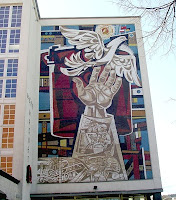Designer: Unknown
Vector Image
 The Australian Institute of Sports (AIS) logo displays strong use of shape, colour and rhythm in its composition, the contrast of colours which are also the main colours of the Australian flag allow the large central shape to ‘pop’ out at a viewer. Its simplicity in shapes becomes very easy on the eye and the rhythmic loop created by the dynamic direction of the blue shapes draws the focus down towards the title. This smooth transition of focus from center to top and back down to the bottom ensures that someone will see and remember the entire image.
The Australian Institute of Sports (AIS) logo displays strong use of shape, colour and rhythm in its composition, the contrast of colours which are also the main colours of the Australian flag allow the large central shape to ‘pop’ out at a viewer. Its simplicity in shapes becomes very easy on the eye and the rhythmic loop created by the dynamic direction of the blue shapes draws the focus down towards the title. This smooth transition of focus from center to top and back down to the bottom ensures that someone will see and remember the entire image. The large solid shapes really make the logo what it is, strong and bold, it gives the AIS a clear and identifiable image and identity, this is supported by the equally strong and bold letterform used, creating a rhythmic loop across the logo. For this reason I believe that this logo is extremely effective and successful in achieving its intention, creating a sense of strength and power would seem to be a concept important to a sports industry, teamed with the colours reminiscent of the Australian flag, the symmetrical composition and word Australian above all other text create a sense of unity and nationalism, which is important aspect when designing for a national institution.
Olympics - Montreal 1976
Designers: Ernst Roch & Rolf Harder
Poster
 The Montreal Olympic games poster is an excellent and very original adaptation of the Olympic rings. The use of scale and positive/negative space is most prominent around the logo, whereas the use of repetition and line make the logo stand out. A strong sense of movement is created through the repetition of the rings, fading outward helps to maintain focus on the centre of the poster and imagery.
The Montreal Olympic games poster is an excellent and very original adaptation of the Olympic rings. The use of scale and positive/negative space is most prominent around the logo, whereas the use of repetition and line make the logo stand out. A strong sense of movement is created through the repetition of the rings, fading outward helps to maintain focus on the centre of the poster and imagery. The visual repetition created is symbolic of the movement seen in an Olympic games as well as the idea of the 5 continents of the world converging in Montreal. The scale of rings on the poster and large vast areas of negative space reenforces this idea, having the rings significantly larger than all other graphic elements on the page causes this to become the central focal point, much like the concept suggests. Colour is also used in a very subtle way in order to inform a viewer further, the black ring is the only ring that fades out towards the top leading towards the title, also black. The small red logo in the top left and text in bottom left could also be seen as creating a slight rhythmic loop across the design with the far right red ring.
Personally I thought that this poster, amongst all of the other Olympic posters stood out at the museum, it has a very different look and style and had the ability to set itself apart from the rest, the concept of movement, unity and convergence of the world also stood out and separated itself from all other Olympic themes.
http://tiny.cc/rgjul
http://tiny.cc/xcsop
http://tiny.cc/rdiyg





















